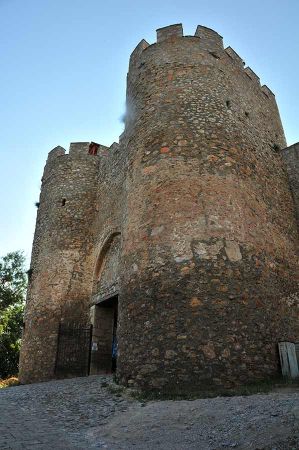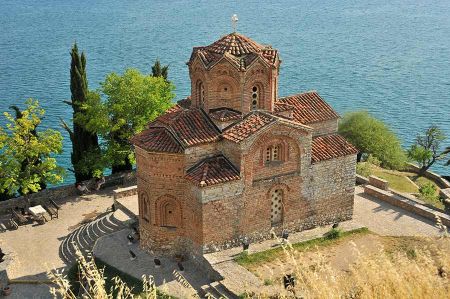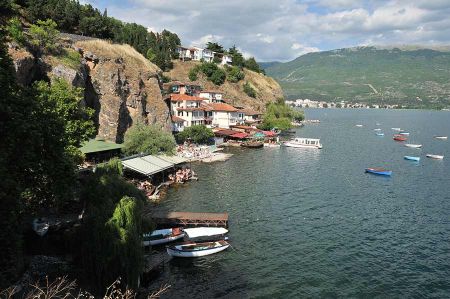Day trip to Lychnidos - today called Ohrid
- Written by Portal Editor
Early in the morning of the following day we had arranged to meet with Perparims father for a trip to the nearby town of Ohrid on the same named lake. We took the advantage of a narrow, winding road along the lakeshore, which led us directly into the city center.
Along the way there were initial information from Rino about the city itself and also of the first, tentative attempts to establish more tourism. Forerunner of the modern town of Ohrid, we quickly learned, was once located on the highest point next to the lake as a mound settlement, which was known as Lychnidos.
Excavation sites Lakočeresko Gradište and Koselski

Scientific excavations revealed the different cultures from the Neolithic to the Iron Age. Dolno Trnovo, located in the City of Ohrid, is a Neolithic excavating place from the 4th-3rd millennium BC. The excavation places Lakočeresko Gradište and Koselsko Gradište belong to the Bronze Age. In Gorenci, some evidence was found from the Iron Age.

The first inhabitants of the region, which can be assigned historically relatively safe, were the Illyrian tribes. They lived in the region around Lake Ohrid during the 8th and 7th century BC. The Encheläern and other immigrant communities followed later - exactly when is unknown - which were too kind of Illyrian tribes under whose incursions neighbouring Macedonia in the 5th and 4th centuries BC repeatedly suffered... Philip II. of Macedon wrest the town Lynkestis and thus extended his influence temporarily also up to the shore of Lake Ohrid around 355 BC.
Lychnidos under Roman rule
At this time Lychnidos became an important stopover of trading on the Roman Via Egnatia, the trade road between Byzantium, later Constantinople and the eastern shores of the Adriatic in Durres. We had explored parts of the route during our journey to Lake Ohrid, because the northern route of the Via Egnatia leading from the Shkumbin Valley, crossing the pass Qafë Thana in today's Albania, then crossed the Black Drin in Struga and went further on to the North-eastern shore of the lake after Lychnidos. From there it continues to Heracleia Lyncestis, today Bitola where it reunited with the southern route, which led past the Lake Prespa.
Getting into the theatre area and looking at the age of the city system way, the narrow and sometimes steep streets were never intended for road transport in the modern sense. The theatre was built around the year 200 BC and it is the only Hellenistic theatre in the whole of Macedonia of that time. During the Hellenistic period comedies, tragedies and dramas were performed. With the Romans , gladiator and animal fights were added. In the top three rows of seats, some inscriptions of personal names are attached, which probably served as seat reservations during performances. A total of twelve seats in the public gallery could (lat. Cavea) survived.
With the Romans came gladiator and animal fights
During the Roman period Lychnidos grew to the east up till the hill Deboj. In the early Christian era in the city emerged seven churches, which pointed to a religious center in the region. In late antiquity Lychnidos was even a bishopric. With the bishop of Dionysos, Lychnidos is attested as a participant of the Synod of Serdica in 343 AD. He was the only known Metropolitan of the city. In the second half of the 5th century a three-nave church was built, which had received a baptistery and a so called Catechumenum room. The church mainly possessed numerous mosaics from fauna and flora in the Baptistery. On 29 and 30 May 526 AD Lychnidos was heavily damaged by an earthquake. Many residents were killed. The fate of the city is unknown. Since that date, no more records about the city Lychnidos were found. Only three centuries later Lychnidos woke up back to life as Slavic town called Ohrid.
Lychnidos badly damaged by an earthquake
It is a shame how little respect such a settlement site puts on the long-term appreciation and conservation, which, with good concept involving the Via Egnatia, certainly would allow tourists to use the place more effective than having a whatever building, could ever be achieve.
Clearly, there is a lack on a holistic approach.
A subsequent tour through Ohrid shows the ancient pavement in the narrow streets of the old town. We are surprised when we learned that it has further replacements in the city center, the massive patch exchanged with concrete slabs. Hopefully at least the old city part with the lovingly decorated houses remain. We too found a small printing company, where there are printed individual layouts according to the old art of printing pages on self-made paper and after sell it to tourists. Even downtown is very busy in despite of cool November weather. We will come back, because there is still much more to discover.
Please read as well:
The awaking cormorant in the morning light at Lake Ohrid
Heracleia Lyncestis - a day trip to Bitola
-
-
-
-
-
-
-
-
-
-
-
-
-
-
-
https://www.alaturka.info/en/macedonia/ohrid/3430-day-trip-to-lychnidos-today-called-ohrid/amp#sigProId5315c37439
